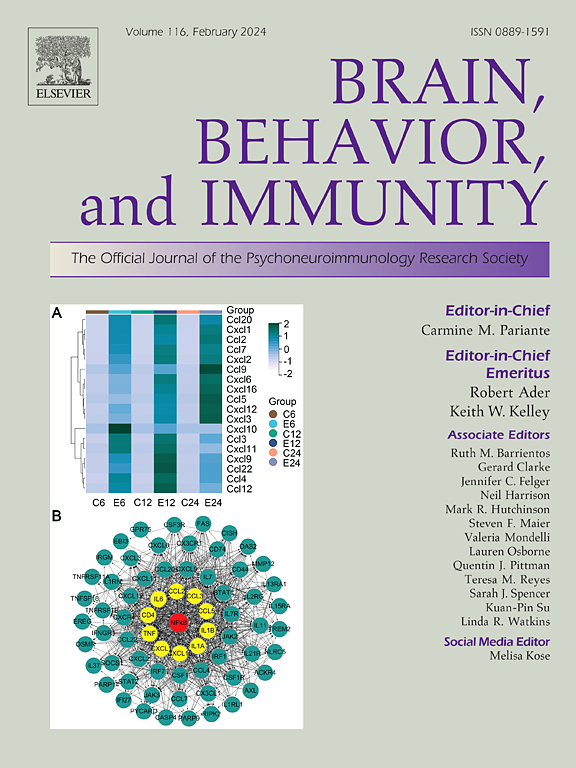雌性小鼠脊髓损伤神经炎症反应和感觉功能障碍的长期动态。
IF 8.8
2区 医学
Q1 IMMUNOLOGY
引用次数: 0
摘要
创伤性脊髓损伤(SCI)后脊髓内发生的神经炎症反应被广泛认为是影响损伤发生后继发性组织损伤进展和严重程度的主要因素。因此,旨在减少继发性损伤的免疫调节疗法是脊髓损伤研究的一个值得注意的重点。为了为未来的研究提供信息,旨在开发此类疗法,我们在挫伤性脊髓损伤后的前6个 月内,对小鼠脊髓神经免疫反应的动力学进行了详细描述。雌性野生型(C57BL/6)小鼠在T9时接受中度脊髓挫伤(n = 8/组),对照组小鼠为naïve (n = 6/组)。包括损伤后1 天至6 个月的9个终末评估时间点(每个时间点重复1至4次)。在每个终末时间点,通过流式细胞术评估脊髓内T细胞、辅助T细胞、细胞毒性T细胞、调节性T细胞、巨噬细胞和小胶质细胞的水平。运动(空地任务)和感觉(甩尾)功能的测量被用来评估行为恢复。小鼠脊髓神经免疫反应呈现双相模式,在损伤后的前2 周出现外周免疫细胞浸润的一个高峰,随后在损伤后2 个月出现第二个高峰。损伤后6 个月,与对照组相比,损伤脊髓中的T细胞和巨噬细胞均保持升高。脊髓炎症与感觉功能损伤急性加重相关,但与损伤后6 个月感觉功能更大的正常化相关。损伤后6 个月较高的炎症也与脾脏与身体质量比的增加有关。总之,这项研究的结果强调了脊髓损伤神经炎症反应的持久性,并表明其与其他身体系统的关系即使在损伤的慢性晚期也在继续发展。本文章由计算机程序翻译,如有差异,请以英文原文为准。
Long-term dynamics of the spinal cord injury neuroinflammatory response and sensory dysfunction in female mice
The neuroinflammatory response which takes place within the spinal cord following a traumatic spinal cord injury (SCI) is widely recognized as a major influencer of the progression and severity of the secondary tissue damage which occurs after injury onset. Immunomodulatory therapies aimed at reducing secondary injury are, therefore, a notable point of focus in SCI research. To inform future studies aimed at development of such therapies, we present a detailed characterization of the dynamics of the spinal cord neuroimmune response in mice throughout the first 6 months after contusive SCI.
Female wild type (C57BL/6) mice received moderate spinal cord contusions at T9 (n = 8/cohort) while control mice remained naïve (n = 6/cohort). Nine terminal assessment time points were included, ranging from 1 day to 6 months post-injury (each timepoint was replicated between one and four times). At each terminal time point, levels of T cells, helper T cells, cytotoxic T cells, regulatory T cells, macrophages, and microglia within the spinal cord were assessed via flow cytometry. Measures of locomotor (open-field task) and sensory (tail flick) function were used to assess behavioral recovery.
The spinal cord neuroimmune response in mice exhibited a biphasic pattern, with one peak of peripheral immune cell infiltration within the first 2 weeks post-injury, followed by a second peak at 2 months post-injury. Both T cells and macrophages remained elevated in injured spinal cords, relative to controls, at 6 months post-injury. Spinal cord inflammation correlated with exacerbated sensory impairment acutely but correlated with greater normalization of sensory function at 6 months post-injury. Higher inflammation at 6 months post-injury was also associated with an increase in spleen to body mass ratio.
Together, the results of this investigation highlight the persistent nature of the SCI neuroinflammatory response and indicate that its relationship to other bodily systems continues to evolve even in the late-chronic stage of injury.
求助全文
通过发布文献求助,成功后即可免费获取论文全文。
去求助
来源期刊
CiteScore
29.60
自引率
2.00%
发文量
290
审稿时长
28 days
期刊介绍:
Established in 1987, Brain, Behavior, and Immunity proudly serves as the official journal of the Psychoneuroimmunology Research Society (PNIRS). This pioneering journal is dedicated to publishing peer-reviewed basic, experimental, and clinical studies that explore the intricate interactions among behavioral, neural, endocrine, and immune systems in both humans and animals.
As an international and interdisciplinary platform, Brain, Behavior, and Immunity focuses on original research spanning neuroscience, immunology, integrative physiology, behavioral biology, psychiatry, psychology, and clinical medicine. The journal is inclusive of research conducted at various levels, including molecular, cellular, social, and whole organism perspectives. With a commitment to efficiency, the journal facilitates online submission and review, ensuring timely publication of experimental results. Manuscripts typically undergo peer review and are returned to authors within 30 days of submission. It's worth noting that Brain, Behavior, and Immunity, published eight times a year, does not impose submission fees or page charges, fostering an open and accessible platform for scientific discourse.

 求助内容:
求助内容: 应助结果提醒方式:
应助结果提醒方式:


